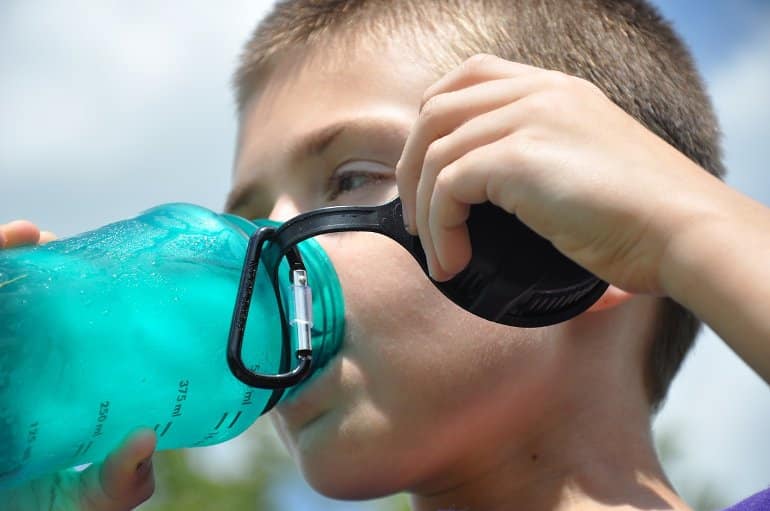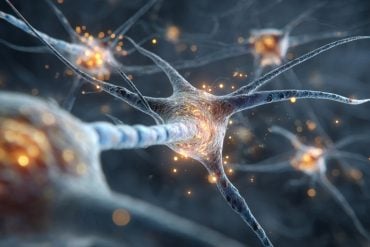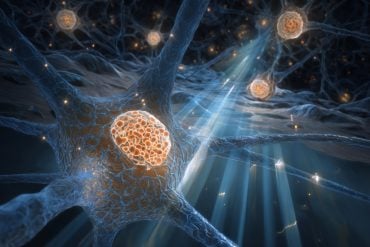Summary: A new study sheds light on the gut-to-brain osmolality signaling that regulates thirst, revealing a sensory pathway that mediates the process.
Source: CalTech
Drinking a glass of water is often sufficient to quench thirst after exercising. But while the sensation of thirst may be satiated after just a few minutes of drinking, the process of rehydration actually takes around half an hour.
The delay occurs because the brain receives signals that you drank water before the body is fully rehydrated based on the detection and measurement of osmolality levels in the gut. Osmolality represents the concentration of dissolved materials including sodium and glucose.
The laboratory of Caltech biologist Yuki Oka has worked to learn more about the gut-to-brain osmolality signaling that regulates thirst, and now his team has discovered the major sensory pathway that mediates this process.
Oka, professor of biology, Chen Scholar, and Heritage Medical Research Institute Investigator; and his lab collaborated on the research with the lab of David Anderson, Seymour Benzer Professor of Biology and Howard Hughes Medical Institute Investigator. Anderson is the Tianqiao and Chrissy Chen Institute for Neuroscience Leadership Chair and director of the Tianqiao and Chrissy Chen Institute for Neuroscience at Caltech, of which Oka is also an affiliated faculty member.
A paper describing the study appears in the journal Nature on January 26.
Blood has high osmolality when our bodies are dehydrated, which triggers the feeling of thirst. But because of the time delay between when we feel quenched and when the body is fully rehydrated, the gut must sense osmolality changes before they happen in the bloodstream, and it must send this information to the brain.
Once we ingest food and water, nutrients are absorbed from the intestine to the liver through the specialized blood vessel called the portal vein. During this absorption event, osmolality signals are also detected by sensory neurons in the gut. In the research, led by postdoctoral scholar Takako Ichiki and graduate student Tongtong Wang, the team examined how the gut communicates this information to the brain to indicate thirst or satiation.
There are two major sensory pathways from the gut to the brain: the spinal (dorsal root ganglia, or DRG) and vagal pathways. In this study, Ichiki used genetically engineered mice to visualize neural activation patterns in these two pathways. She then systematically monitored DRG and vagal neurons in response to infusions of water, salt, or sugar into the mouse intestine that mimic normal nutrient ingestion.
The team found that the vagal neurons, but not spinal neurons, are strongly activated upon osmolality changes in the gut. In fact, distinct subsets of neurons were active in response to the different liquids.
The next question was: What part of the gut sends the osmolality information to the brain? The team examined the hepatic portal area (HPA), a major blood vessel running through the gut responsible for absorbing the vast majority of nutrients from the intestine and carrying them to the liver.
They found that vagal nerves innervating the HPA indeed carry osmolality signals. Severing a specific vagal nerve branch to the HPA eliminated the ability of vagal neurons to respond to changes in osmolality.

The team further investigated whether vagal nerves directly or indirectly sense osmolality changes in the gut. They found that, in response to osmolality changes in the intestine, one particular peptide, the vasoactive intestinal peptide, or VIP, is secreted into the portal vein, which in turn activates vagus nerves in the HPA area. This explains how the gut translates physical osmolality changes into hormonal signals that encode osmolality changes.
“We have discovered the beginning of a pathway, the HPA-to-brain axis,” says Oka, who is also a New York Stem Cell Foundation Investigator. “The details of all of the connections and molecular mechanisms are still to be determined.”
Additional future research will examine the connections between the vagal neurons in the body and the regions of the brain known to control thirst. In previous work, Oka lab researchers identified so-called thirst neurons within the brain’s subfornical organ (SFO) region. When animals are thirsty, these neurons are highly active; drinking water rapidly calms them down. But the SFO thirst neurons are not directly connected to any gut neurons, so the team aims to figure out how changes in osmolality are communicated to the SFO thirst neurons.
“There is still so much that we don’t know about how the nervous system controls basic functions, like thirst and satiety,” says Karen David, Ph.D., program director at the National Institute of Neurological Disorders and Stroke. “This study shows how approaches supported by the BRAIN Initiative are being used to uncover how brain circuits handle this important sensory information.”
About this neuroscience and thirst research news
Author: Lori Dajose
Source: CalTech
Contact: Lori Dajose – CalTech
Image: The image is in the public domain
Original Research: Closed access.
“Sensory representation and detection mechanisms of gut osmolality change” by Takako Ichiki et al. Nature
Abstract
Sensory representation and detection mechanisms of gut osmolality change
Ingested food and water stimulate sensory systems in the oropharyngeal and gastrointestinal areas before absorption. These sensory signals modulate brain appetite circuits in a feed-forward manner.
Emerging evidence suggests that osmolality sensing in the gut rapidly inhibits thirst neurons upon water intake. Nevertheless, it remains unclear how peripheral sensory neurons detect visceral osmolality changes, and how they modulate thirst.
Here we use optical and electrical recording combined with genetic approaches to visualize osmolality responses from sensory ganglion neurons. Gut hypotonic stimuli activate a dedicated vagal population distinct from mechanical-, hypertonic- or nutrient-sensitive neurons.
We demonstrate that hypotonic responses are mediated by vagal afferents innervating the hepatic portal area (HPA), through which most water and nutrients are absorbed. Eliminating sensory inputs from this area selectively abolished hypotonic but not mechanical responses in vagal neurons.
Recording from forebrain thirst neurons and behavioural analyses show that HPA-derived osmolality signals are required for feed-forward thirst satiation and drinking termination. Notably, HPA-innervating vagal afferents do not sense osmolality itself. Instead, these responses are mediated partly by vasoactive intestinal peptide secreted after water ingestion.
Together, our results reveal visceral hypoosmolality as an important vagal sensory modality, and that intestinal osmolality change is translated into hormonal signals to regulate thirst circuit activity through the HPA pathway.







